All about bathtub skirting boards
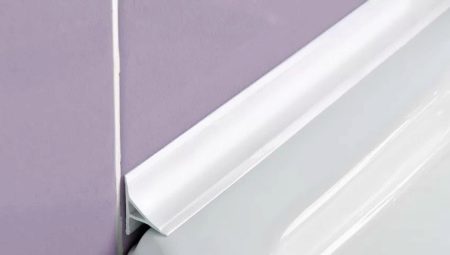
When installing the bath, it is important to take care of sealing the joint that forms between the font and the wall. For these purposes, special borders (plinths or fillets) have been created. They are made of different materials and can be mounted in different ways. Each type of border has certain features, pros and cons that should be considered before buying.
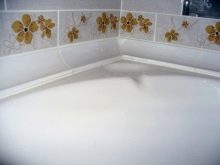
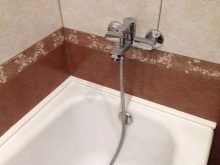
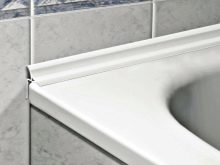
Appointment
When installing a bath or shower stall, a gap often forms. It occurs for a number of reasons:
- walls not erected at right angles;
- wall surfaces with flaws (protrusions, pits and other defects);
- violations committed during the installation of plumbing equipment.
The gap created between a wall and a bathtub, shower tray or sink can be a serious problem. During hygiene procedures, water will seep even into a small crevice. As a result, the liquid will flow down the surface of the wall, which often leads to stains on the ceiling of the neighbors below.
Flooding risks are not the only concern. In the bathroom, the conditions are difficult - high humidity is often noted here. If water constantly seeps into the gap between the plumbing and the wall, this will lead to the appearance of fungus. Such microorganisms multiply rapidly, harming the health of households. To prevent water from flowing onto the walls and floor, a bath corner is used. It will reliably protect the room from leaks.
Another important function that the skirting board performs is aesthetic... The slots left after the installation of plumbing equipment can spoil the overall picture.They make the room look untidy and give the interior a feeling of unfinishedness. Using the border, you can correctly and aesthetically close up the formed joint.


Varieties
Modern curbs are produced in several design variations, they can have all kinds of colors and be made from different raw materials. According to the method of design, the products are divided into:
- internal - intended for installation at the connection points before performing the facing work (first, the curb is mounted, and only after that the tiles are laid);
- external - intended for installation on joints over a wall cladding.
And also the sides differ in the installation method. There are flexible self-adhesive and non-self-adhesive solutions. The inner part of the former is treated with a specialized glue, protected from drying by a thin shell. After removing the film, the curb must be immediately attached to the tile. Non-adhesive corners are mounted with silicone or acrylic sealants.
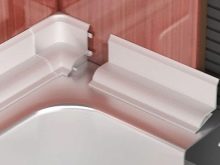
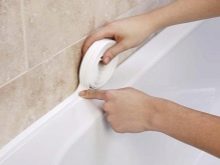

Skirting boards are classified according to the raw materials from which they are made. Let's talk about each variety in more detail.
Plastic
The PVC border has many advantages. It has optimal elasticity and many color options. Plastic resists moisture well, does not deform during temperature extremes. Due to the variety of colors, you can choose a corner for almost any type of wall cladding. Another advantage of the plastic corner is the budget cost.
PVC products are made as self-adhesive finishing fillets intended for installation on top of tiles, or as interior solutions installed under the finishing at the initial stage of cladding. The disadvantages of plastic solutions include fragility.
After 2-4 years, they lose their external aesthetics and require replacement. White plastic turns yellow over time, which can ruin the look of the bathroom. In addition, traces of cleaning agents or hard sponges can remain on PVC curbs, so they require careful maintenance.
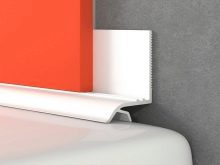


Ceramic
It is not difficult to choose a beautiful and high-quality fillet for the bathroom - these products are sold in various standard sizes and color variations. Other advantages of ceramic corners include:
- water resistance achieved through a special glazed layer that repels liquid;
- high strength indicators - ceramic products are able to withstand some mechanical loads (weak impacts, abrasion), while maintaining external perfection;
- durability - due to the resistance of such borders to the microclimate in the bathroom and various mechanical influences, they can last at least 20 years;
- resistance to chemically aggressive detergents;
- excellent decorative qualities.
Despite the significant advantages, not everyone prefers ceramic fillets. There are a number of arguments for this. Ceramic corners are expensive, especially when compared to budget PVC counterparts. Products of European brands will cost the most.
Another disadvantage is fragility. Curbs break easily with strong impacts or falls. If something heavy falls on the installed corner, it may crack. Water gets into such cracks, as a result of which harmful microorganisms begin to develop there.
The ceramic skirting board is installed using tile adhesive. It will take experience and utmost patience to fix it smoothly and neatly. Not everyone can cope with the task of sealing joints with a ceramic corner.
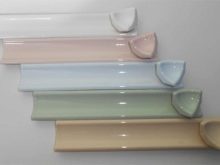
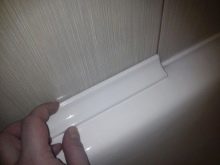

Rubber
Rubber corners are highly flexible, due to which they are recommended for use in places with frequent bends. The material is highly resistant to temperature extremes, which is why it does not deform when exposed to hot and cold water. Rubber products are inexpensive, but at the same time fully cope with the tasks assigned to them.
Such borders also have some disadvantages. Judging by the reviews, they quickly lose their external presentability when cleaning with agents with chemically aggressive compositions. Their appearance often suffers when cleaning with powdered substances with abrasive particles.
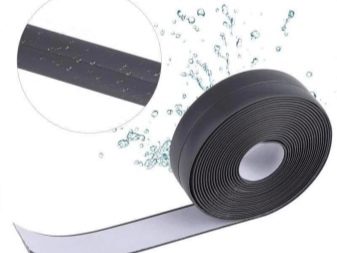
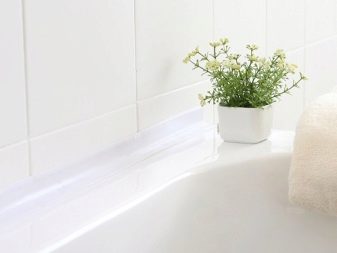
Metal
Metal products have many benefits. They are durable, reliable, stylish and expensive looking. Such corners are made of stainless metals, they are often coated with special compounds that protect the product from corrosion.
Metal fillets are more expensive than popular plastic or silicone skirting boards, but with proper care they will last several times longer. The disadvantages of curbs include the difficulty of choosing the optimal solution for the interior of the room and the design of plumbing equipment. In order not to “miscalculate”, it is recommended to think over the details of the bathroom design in advance and provide for the presence of various metal parts, interior items or decor.
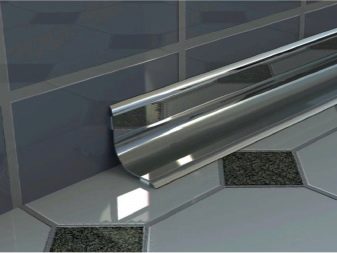
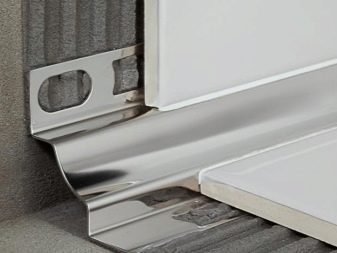
Curb tape
For the production of self-adhesive border tape, polymer materials are used. Such products have different widths, so it is possible to choose the best solution for yourself. Curb tape is inexpensive. It is easy to install - even a beginner can cope with the task of sealing joints.
The disadvantage of this product is fragility due to the loss of aesthetic qualities and loss of sealing during operation.... Customers complain that they have to re-tape the tape every 2 years. If you use abrasives, alkaline or acidic products to maintain cleanliness, you will have to reseal the joints even more often.

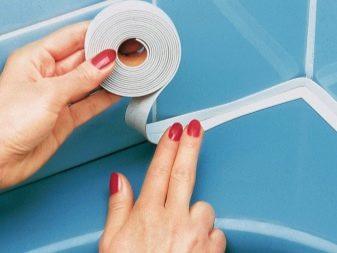
Silicone
The physical properties of silicone skirting boards are similar to those of rubber products. They have increased elasticity, due to which such curbs are used for sealing joints in places with maximum bends. Silicone corners are inexpensive and presentable, but they require gentle maintenance. They cannot be cleaned with abrasives, alkaline and acidic compounds. Otherwise, they will quickly lose their aesthetics.
Most silicone corners are self-adhesive and have a sticky adhesive on the inside. When buying, you need to pay attention to the production time of the product. The older the product, the worse the properties of the adhesive. In this case, it will not be possible to achieve absolute sealing of the joints.
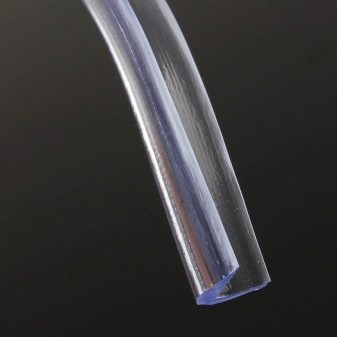

Acrylic
Acrylic corners are recommended for acrylic fonts. Such skirting boards are in great demand, despite their higher price compared to their silicone and plastic counterparts. Advantages of acrylic corners:
- various design variations - products are available in a wide color palette, so you can easily find a solution for any bathroom design, regardless of the general color in which the room is decorated;
- strength - acrylic can withstand severe mechanical stress;
- durability;
- resistance to chemically aggressive detergents.
The most popular curbs are products from the Superplinth company.... Full-bodied corners are produced under this brand, suitable for edging all types of bathtubs.
The disadvantages of acrylic corners include their weak elasticity, which is why they are not recommended for edging plumbing fixtures with complex geometric shapes. Otherwise, the product with excessive bends will easily burst.
An important feature to look out for is the poor resistance to thermal expansion.Because of this, acrylic fillets cannot be used to seal joints between walls and metal bathtubs.
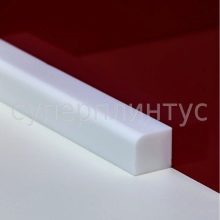
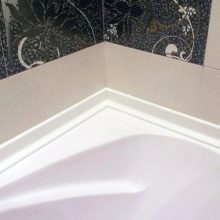

Artificial stone
Artificial stone borders are obtained by using acrylic resins, various minerals and pigment compounds that give color to the finished product. Such corners are hygienic - due to the absence of micropores, they do not absorb moisture and perfectly resist the growth of fungi and harmful microorganisms leading to the formation of mold... In addition, they are versatile - fillets can be used both for sealing joints and for hiding the seams between the floor and wall cladding in the bathroom.
An artificial stone skirting board looks aesthetically pleasing and expensive. It is able to withstand serious mechanical stress, sudden temperature changes. These types of borders are absolutely safe for health - they do not emit harmful substances when heated.
With proper installation, stone products can serve for more than a dozen years. At the same time, the corners will not fade and will not lose their original color even with intensive use and daily washing. The disadvantages of products include them absolute inelasticity, high cost and difficult installation.
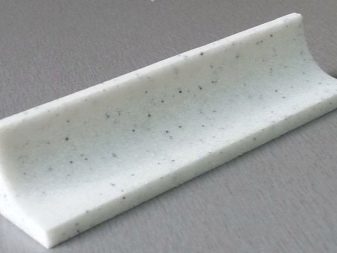
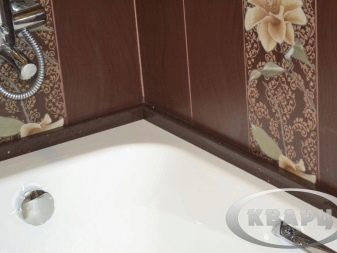
Dimensions (edit)
In addition to the variety of types, the windows of plumbing shops are full of vast variations in sizes. The width of the plinth is of great importance, since to some extent the completeness of the bathroom design will depend on this type of finish.
Basically skirting boards are up to 30 mm wide. This size is sufficient to seal small, medium and large gaps. There are also non-standard wide decorative borders 50 or 60 mm wide.
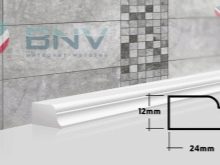
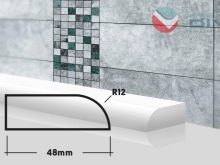
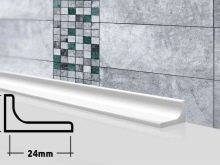
Selection Tips
In order to choose the right plinth for edging plumbing fixtures, it is important to consider several factors.
- The material with which the walls are lined. If the bathroom is finished with PVC panels, it is advisable to select corners for sealing from the same polymer.
- The material for making a bath or shower. For example, for acrylic products, it is recommended to select acrylic fillets.
- The width of the gap between the bathroom and the wall. If the gap is large, it is recommended to give preference to full-bodied corner-shaped borders.
- Colors. The color of the skirting boards should match the color of the trim or bath. Fillets should ideally fit into the interior and complement it, without getting out of the general style. Basically, manufacturers produce white borders, less often products in light pink, pale blue or pale green are on sale. There are decorative skirting boards with curly trimming or embossing.
The purchased bathroom curb must be completely airtight. It should not absorb moisture and create an environment conducive to the development of mold microorganisms.
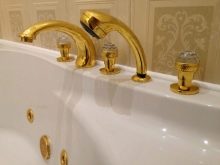
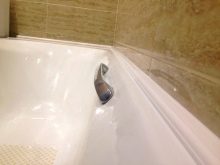

Installation features
A home master will also be able to qualitatively install the border. In order for the edging to be airtight and aesthetic, you should know the procedure. Let's consider how to mount a corner using the example of PVC fillets and self-adhesive tape.
Plastic curbs
Installation of skirting boards includes several stages.
- Dismantling of the old sealing. The loose or mildewed curb is carefully separated from the wall and bathtub with a spatula. After that, the surfaces are cleaned from dust and dirt.
- Preparation of the base... In order to remove dirt residues, the surfaces are wiped with a cloth soaked in a chlorine solution with water. It is allowed to use white spirit - in this case, the base will be degreased. After that, the walls are given time to dry completely. To speed up the process, you can use a hairdryer.
- Measurements - the length and width of the sanitary ware are measured using a tape measure. After that, the markings are applied on the curb.
- After measurements, the required length is cut from the plinth (It is important to trim the edges at a 45 degree angle for nice interior corners). Next, a preliminary fitting is performed.
- Fixing masking tape. The border should be glued along its entire length at a level of 0.2 cm along the upper and lower borders. After the corner is removed, the masking tape remains.
- Adhesive application... Places where fillets are installed are treated with a sealant or foam. You need to work carefully so as not to go beyond the masking tape.
- Fixation. The plinth is applied to the applied adhesive and pressed lightly. Any excess glue that comes out should be removed with a cloth.
- Sealing. At the last stage, the edges of the curb are folded back and processed with a sealant.
Adhesives and sealants must be applied in an even and thin layer over the entire surface of the curb. Spot application is not allowed.
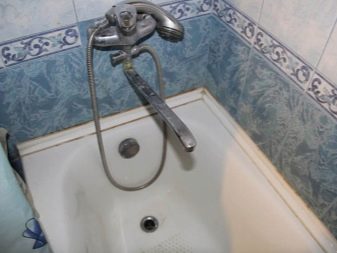
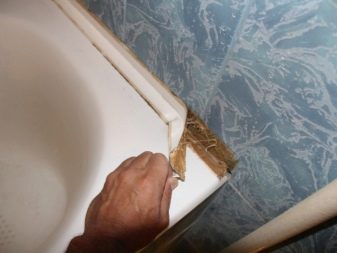


Self-adhesive tape
To install the sealing tape, you must carefully prepare the base - remove the old skirting board, clean the surface from dirt and let it dry. Before gluing the tape, markings are applied to it - the length of its segments should be 2-3 cm longer than the measured sides of the bath. After cutting, the material is folded along its entire length and heated with a household hair dryer. The thermal effect gives the tape more elasticity, thereby reducing the risk of its premature detachment from surfaces.
It is necessary to start glueing the plinth from one of the corners. The protective film should not be removed all at once - it is removed gradually, by 10-20 cm. During installation, they try to press the material tightly using the applicator. The joints in the corners are additionally treated with sanitary sealant. It is not recommended to use plumbing fixtures until the glue is completely dry. If you find that the tape has come off in places - do not panic. In this case, the material is carefully glued using "liquid nails" or sealant.
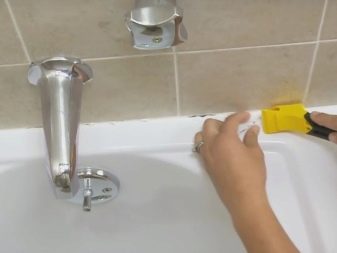
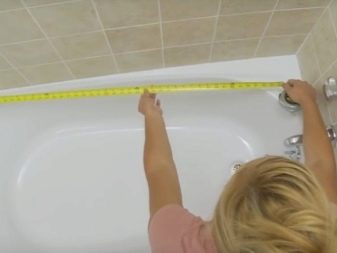
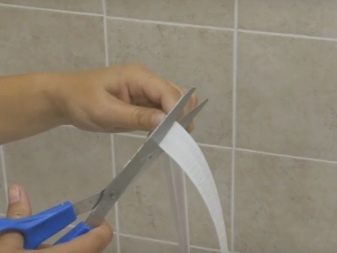

Next, watch a video on how to properly install the curb on the bathtub.








